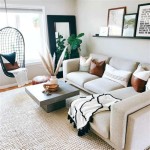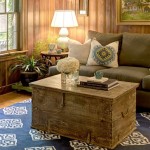Harmonizing Kitchen and Living Room Decor: A Comprehensive Guide
The kitchen and living room often function as central hubs within a home, spaces where individuals and families gather, cook, relax, and entertain. Consequently, creating a cohesive and aesthetically pleasing flow between these two areas is crucial for enhancing the overall comfort and functionality of the living space. The goal is to establish a harmonious design that reflects personal style while optimizing the use of available square footage. This article explores various decor ideas for seamlessly integrating the kitchen and living room, focusing on color palettes, furniture selection, lighting solutions, and the incorporation of complementary design elements.
Establishing a Unified Color Palette
Color plays a fundamental role in defining the atmosphere of a room. Maintaining a consistent color palette between the kitchen and living room creates a visual connection and prevents a disjointed appearance. This does not necessarily mean using the exact same shades throughout both rooms, but rather selecting a core set of colors that complement each other and are used strategically in each space.
One approach is to choose a neutral base color, such as a soft gray, beige, or off-white, for the walls of both the kitchen and living room. This provides a blank canvas upon which to build a more nuanced color scheme. Accent colors can then be introduced through furniture, accessories, and artwork. For instance, if the kitchen features cabinets in a warm wood tone, the living room could incorporate similar wood accents in the coffee table, shelving, or picture frames.
Another effective technique is to use different shades of the same color family. For example, a light blue in the kitchen's backsplash can be echoed with a deeper navy blue in the living room's throw pillows or area rug. This creates a subtle yet cohesive link between the two spaces. It is also important to consider the existing natural light within each room. Lighter colors tend to work better in spaces with limited natural light, while darker colors can add depth and drama to rooms with ample sunlight.
When selecting a color palette, it is beneficial to consider the overall style of the home. A modern aesthetic often favors a monochromatic color scheme with pops of bold color, while a more traditional style may incorporate warmer, earthier tones. Ultimately, the chosen colors should reflect personal preferences and create a welcoming and comfortable environment.
Strategic Furniture Selection for Seamless Transition
Furniture serves as a crucial element in defining the layout and functionality of both the kitchen and living room. Choosing furniture pieces that complement each other in style, scale, and material can significantly enhance the visual flow between the two spaces. In open-concept designs, where the kitchen and living room are directly connected, the furniture acts as a natural transition, defining the boundaries of each zone without creating a stark separation.
One key consideration is the material of the furniture. If the kitchen features stainless steel appliances and sleek countertops, the living room can incorporate furniture with similar metal accents or clean lines. Similarly, if the kitchen has a farmhouse-style aesthetic with natural wood elements, the living room can feature reclaimed wood furniture or woven textures. The repetition of materials creates a sense of continuity and harmonizes the overall design.
The scale of the furniture is also important. A large, sectional sofa in the living room can feel overwhelming if the kitchen is small and compact. Conversely, small, delicate furniture in the living room may appear out of place if the kitchen features large, industrial-style appliances. It is essential to choose furniture pieces that are proportional to the size of each space and that complement each other in terms of visual weight.
In open-concept spaces, a kitchen island can serve as a natural divider between the kitchen and living room. The island can be designed to incorporate seating, such as bar stools, which provides a casual dining area and encourages interaction between those in the kitchen and those in the living room. The style of the island should be consistent with the overall design of both spaces, and the countertops should complement the other surfaces in the kitchen and living room.
Finally, consider the functionality of the furniture. Choose pieces that are not only aesthetically pleasing but also practical and comfortable. In the living room, opt for sofas and chairs that are durable and easy to clean, especially if there are children or pets in the home. In the kitchen, choose storage solutions that are both functional and visually appealing, such as open shelving or glass-front cabinets.
Illuminating the Combined Space: Cohesive Lighting Strategies
Lighting is a critical aspect of interior design, impacting both the functionality and ambiance of a space. A well-planned lighting scheme can enhance the visual appeal of the kitchen and living room, highlighting key features and creating a warm and inviting atmosphere. Consistency in lighting styles and color temperatures between the two zones is crucial for achieving a seamless transition.
The lighting strategy should incorporate a combination of ambient, task, and accent lighting. Ambient lighting provides overall illumination, while task lighting focuses on specific areas, such as countertops or reading nooks. Accent lighting highlights architectural features or decorative objects. In the kitchen, recessed lighting or pendant lights can provide ambient light, while under-cabinet lighting can illuminate countertops for food preparation. In the living room, floor lamps, table lamps, and chandeliers can provide ambient and accent lighting.
Consistency in the style of light fixtures is important for creating a cohesive look. If the kitchen features modern, minimalist pendant lights, the living room can incorporate similar styles of floor lamps or table lamps. The use of matching finishes, such as brushed nickel or matte black, can further enhance the visual harmony between the two spaces. It is also important to consider the color temperature of the light bulbs. Using the same color temperature throughout both rooms will create a more uniform and balanced look.
Dimmable lighting is a valuable feature that allows for adjusting the lighting levels to suit different moods and activities. In the kitchen, dimmers can be used to create a more relaxed atmosphere during meal times, while in the living room, dimmers can be used to create a cozy ambiance for movie nights or social gatherings. Smart lighting systems, which can be controlled remotely via a smartphone or tablet, offer even greater flexibility and convenience.
Natural light should also be taken into consideration when planning the lighting scheme. Maximize the amount of natural light that enters the kitchen and living room by using sheer curtains or blinds. Mirrors can also be used to reflect natural light and brighten up the space. When natural light is limited, choose light fixtures that mimic the color and intensity of natural light.
Integrating Complementary Design Elements
Beyond color, furniture, and lighting, specific design elements should be thoughtfully integrated to foster a unified and harmonious aesthetic between the kitchen and the living room. These elements include flooring, window treatments, decorative accessories, and artwork. The consistent application of these elements can significantly contribute to the overall cohesiveness of the combined space.
Flooring provides a strong foundation for the overall design. Choosing a single flooring material for both the kitchen and living room can create a seamless transition between the two spaces. Hardwood flooring is a popular choice for its durability, warmth, and timeless appeal. Alternatively, tile or laminate flooring can be used in the kitchen for its water resistance, while the living room can feature a complementary area rug to add softness and texture. If different flooring materials are used, ensure that they are visually compatible in terms of color and style.
Window treatments can also be used to create a cohesive look. Matching curtains or blinds in the kitchen and living room can tie the two spaces together. Alternatively, different styles of window treatments can be used, as long as they share a common element, such as color or fabric. For example, sheer curtains in the kitchen can be complemented by heavier drapes in the living room, both in the same shade of white.
Decorative accessories, such as throw pillows, blankets, vases, and artwork, can add personality and visual interest to the kitchen and living room. Choose accessories that complement the overall color palette and style of the space. The repetition of certain motifs or patterns can create a sense of continuity. For instance, if the kitchen features geometric patterns in the backsplash, the living room can incorporate similar patterns in the throw pillows or area rug.
Artwork is another important element that can enhance the visual appeal of the kitchen and living room. Choose artwork that reflects personal preferences and complements the overall style of the space. A gallery wall, featuring a collection of prints or photographs, can create a focal point in the living room and tie in with the color scheme of the kitchen. Large-scale artwork can also be used to create a sense of drama and sophistication.

Building An Open Concept Kitchen Living Room In 2025 Foyr

Decor Ideas For An Open Floor Plan Living Room And Kitchen

17 Open Concept Kitchen Living Room Design Ideas Style Motivation

Open Concept Kitchen And Living Room 55 Designs Ideas Interiorzine
:max_bytes(150000):strip_icc()/MichelleBoudreau8926Revision-4318x2880x368x0x3840x2880x1664884559-2756c4d88fc948f29b52ac17580b1912.jpg?strip=all)
28 Open Kitchen Living Room Ideas To Create A Cohesive Space

How To Design An Open Plan Kitchen And Living Room

Stunning Open Concept Living Room Ideas
:max_bytes(150000):strip_icc()/WhiteSands_Pine_008-5555f6a4cbdb410ea74bde652e9d73f5.jpg?strip=all)
28 Open Kitchen Living Room Ideas To Create A Cohesive Space

How To Design An Open Plan Kitchen And Living Room

17 Open Concept Kitchen Living Room Design Ideas Style Motivation







